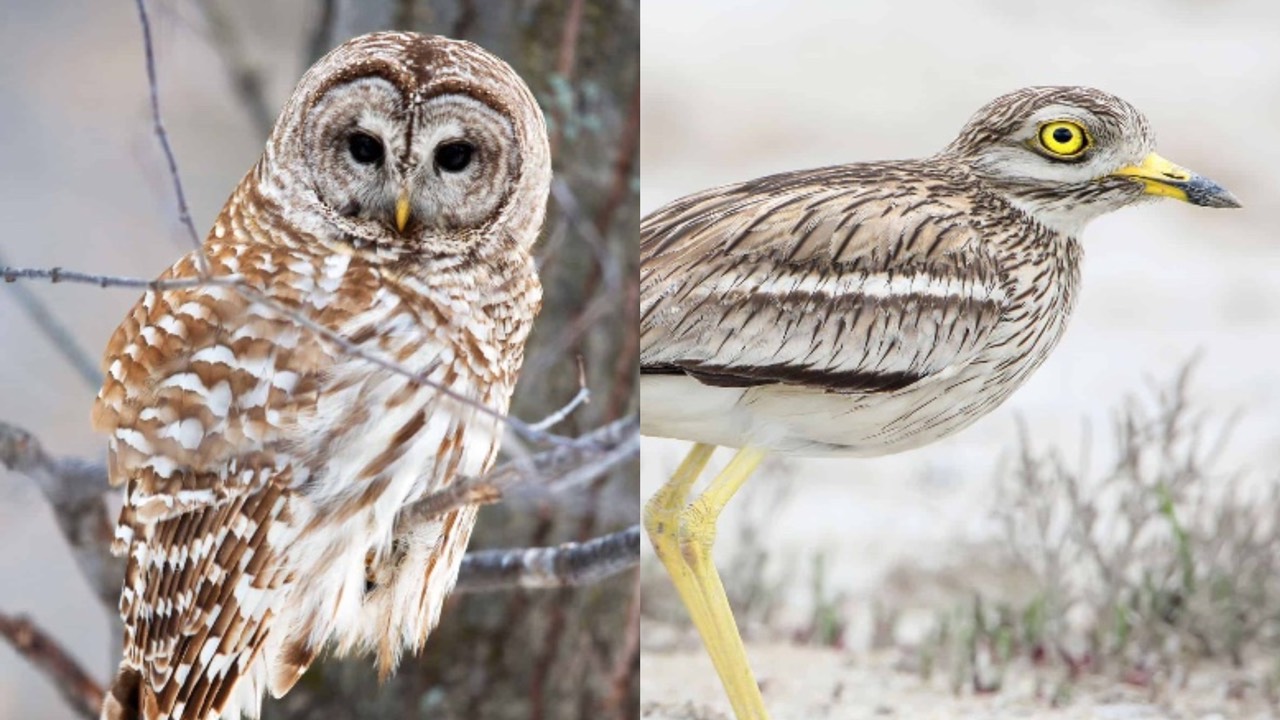
Curious about nocturnal birds? Then you’ve come to the right place! Here we cover 20 of the coolest winged critters of the night as well as what makes a bird nocturnal. Read on to learn all about owls, nightjars, and even a nocturnal parrot!
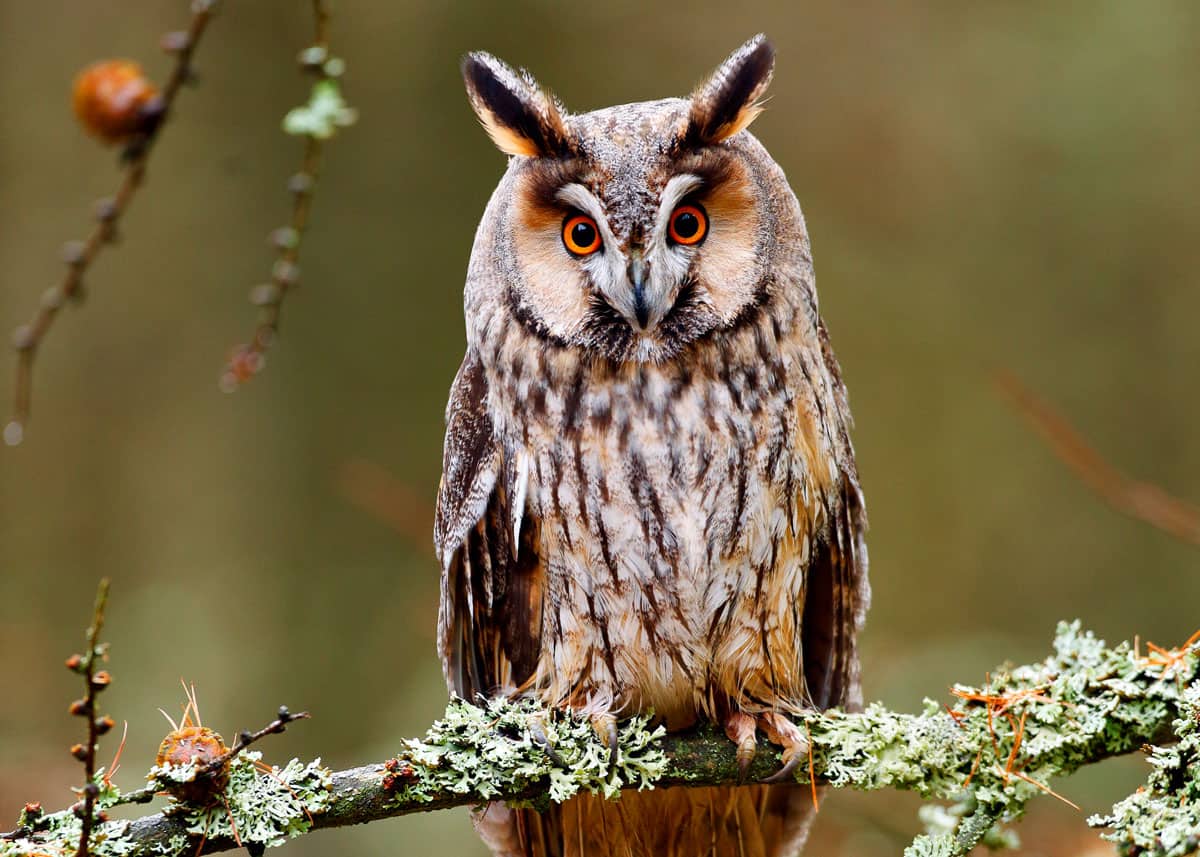
What makes a bird nocturnal?
Some birds are only active at night, meaning they feed or hunt at night, and sleep during the day. Other birds are diurnal (daytime) birds but may sing at night. Then, you have birds that are active at twilight but not the entire night.
Nocturnal birds are different than daytime birds. Birds of the night usually have large eyes, camouflaged plumage, and enhanced senses. They also exhibit different behavior such as freezing up or remaining motionless if disturbed during the day.
2o Nocturnal Birds You’ll Love
Want to know more about which birds are creatures of the night? Check out these 20 nocturnal birds.
1. Barred Owl
- Latin name: Strix varia
- Why they are nocturnal: Hunts at night
- Where they are found: North America
- Size: Length: 19 to 20 inches (48 to 50 cm); Weight: 1.10 to 2.31 pounds (500 to 1,050 g); Wingspan: 38 to 49 inches (96 to 125 cm)
- Diet: Meadow voles, mice, shrews, squirrels, rabbits, birds
You’ve probably heard people refer to owls in general as “hoot owls,” but the barred owl is the real deal.
It is also the only owl in the eastern United States with brown eyes. (All other owls have yellow eyes.)
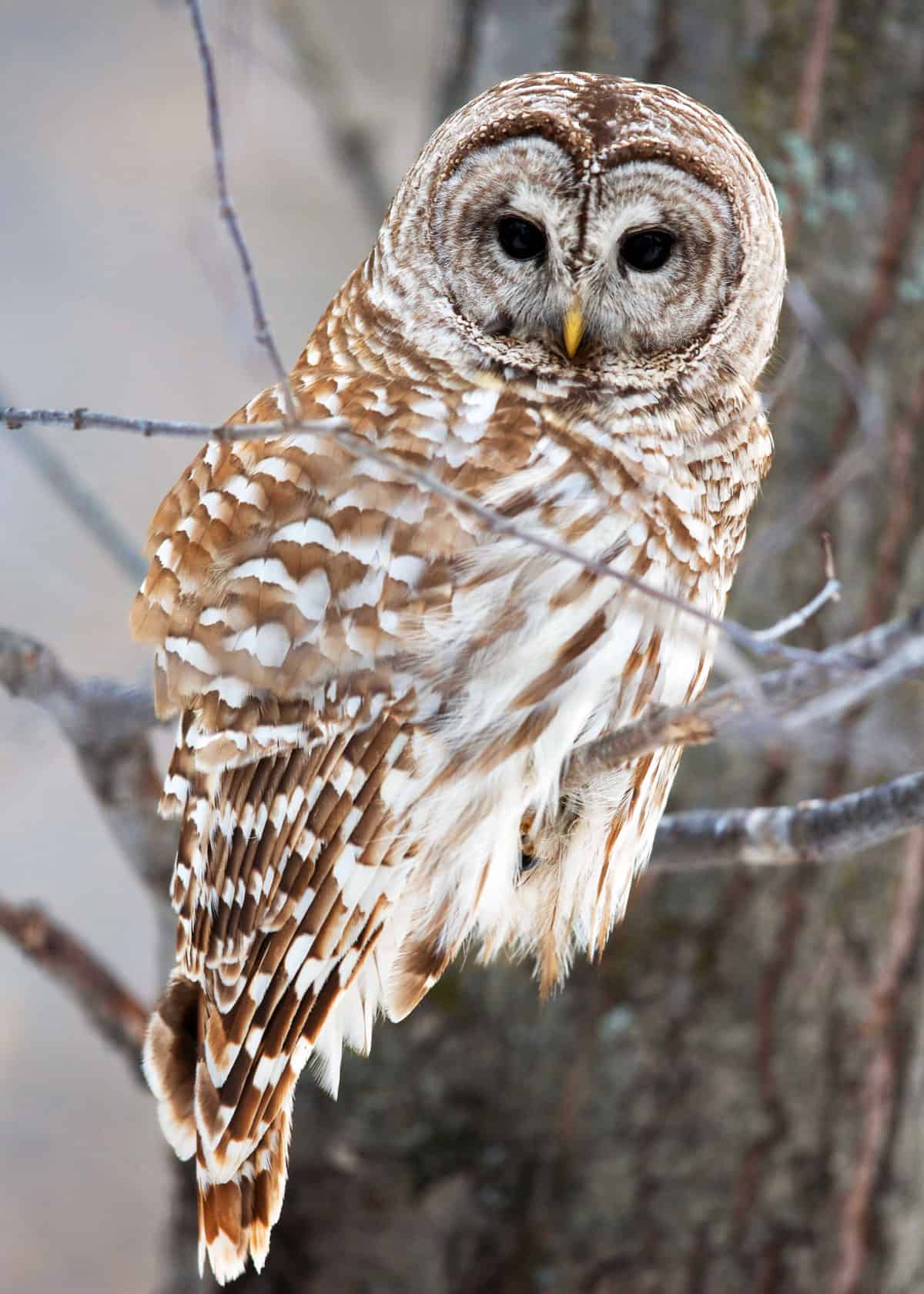
It prefers dozing by day and hunting by night in old growth woodlands but is attracted to city lights where getting hit by a car is a serious threat.
2. Kakapo
- Latin name: Strigops habroptilus
- Why they are nocturnal: Active at night
- Where they are found: New Zealand
- Size: Length: 23 to 25 inches (58 to 64 cm); Weight: 2 to 9 pounds (0.95 to 4 kg)
- Diet: Seeds, fruits, nuts, berries, and fruit of rimu tree
The kakapo is probably one of the world’s most fascinating nocturnal birds. Wearing greenish-yellow plumage that looks more like a coat of moss to match its habitat, this odd bird is one of the heaviest birds in the world.
It’s also the world’s only flightless parrot, but it can “parachute” from a tree. It has a sweet-smelling odor and is friendly toward people.
Its reproduction rate is determined by the cone cycle of the rimu tree, and it has a lifespan longer than many humans (95 years).
3. Large-tailed Nightjar
- Latin name: Caprimulgus macrurus
- Why they are nocturnal: Feeds at night
- Where they are found: Asia and northern Australia
- Size: Length: Length: 10 to 13 inches (25 to 33 cm); Weight: 2.04 to 2.75 ounces (55 to 78 g)
- Diet: Insects (Moths, mosquitoes, crickets, grasshoppers, beetles, wasps, and flying termites)
You may think this nightjar bird is a small pile of dead leaves until it flies away. Nesting on the ground, this bird hides in plain sight because its mottled, brown/gray/tan plumage blends in with its surroundings. Come nightfall, it feeds on flying insects.
4. Night Parrot
- Latin name: Pezoporus occidentalis
- Why they are nocturnal: Active at night
- Where they are found: Australia
- Size: Length: 8.66 to 9.84 inches (22 to 25 cm); Weight: 3.52 ounces (100 g); Wingspan: 17.32 to 18.11 (44 to 46 cm)
- Diet: Grass seeds and herbs
This small, yellowish-green Australian parrot is so adept at staying on the down-low that researchers once believed it was extinct due to no reported sightings between 1912 and 1979.
One of the most mysterious birds in the world, this ground-dwelling parrot stays hidden in dense shrublands by day but can fly up to 62 miles by night in search of food and drinking water.
5. Tawny Frogmouth
- Latin name: Podargus strigoides
- Why they are nocturnal: Active at night
- Where they are found: Australia and Tasmania
- Size: Length: 13 to 21 inches (34 to 53 cm); Weight: 5.5 to 19.6 ounces (157 to 555 g)
- Diet: Nocturnal insects, worms, slugs, frogs, and small mammals and birds
You may find it difficult to detect the tawny frogmouth because its mottled black/gray/white plumage makes it look exactly like tree bark. It resembles an owl but has a large, wide mouth like a frog that it uses to catch flying insects at night.
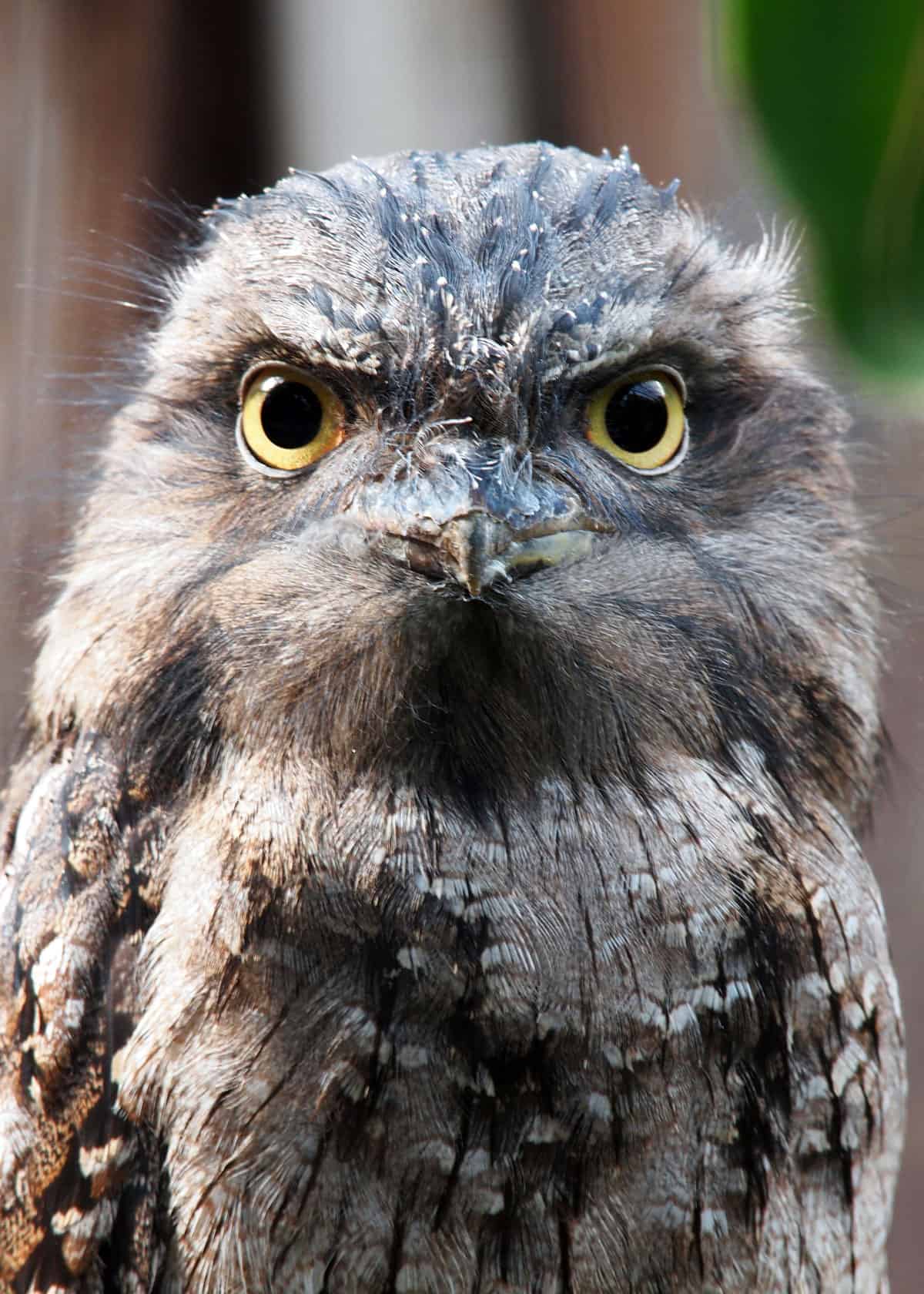
Tawny frogmouths rarely leave their habitats, and small families of this species will line up side by side on a single tree branch.
6. Stone Curlew
- Latin name: Burhinus oedicnemus
- Why they are nocturnal: Hunts at night
- Where they are found: Europe and North Africa
- Size: Length: 15.75 to 17.32 inches (40 to 44 cm);
- Diet: Earthworms, beetles, woodlice, and small mammals and birds
This white and brown-streaked bird has nicknames like “thick knees” for its yellow, knobby knees and “goggle eyes” because of its wide yellow eyes, but its official name comes from its call that sounds like “kur-lee.”
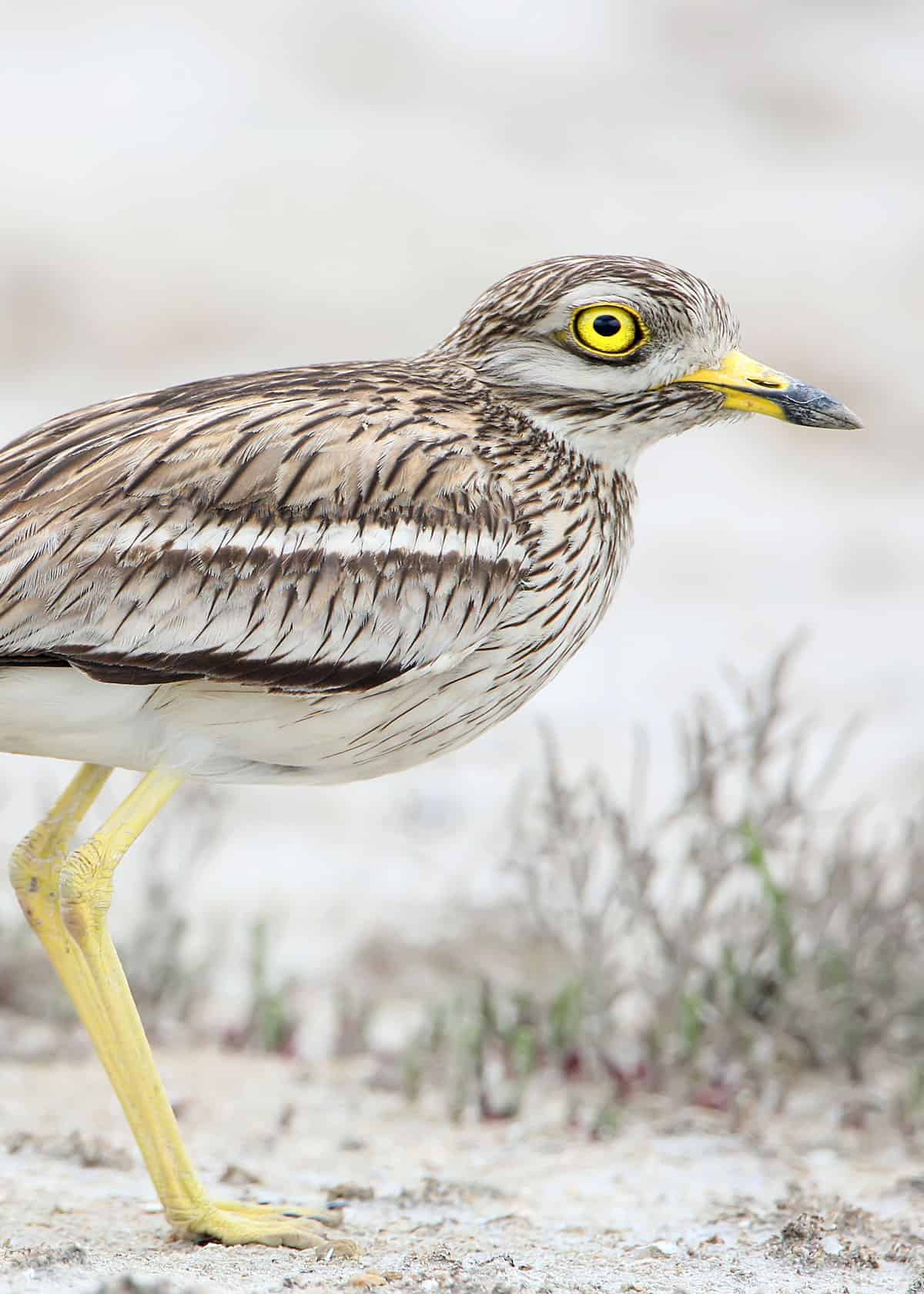
The stone curlew breeds in Europe and overwinters in Spain and Africa. It hunts at night for juicy prey like woodlice and beetles.
7. Mockingbird
- Latin name: Mimus polyglottos
- Why they are nocturnal: Bachelor males sing at night
- Where they are found: North America
- Size: Length: 8.1 to 11 inches (20.5 to 28 cm); Weight: 1.4 to 2.0 ounces (40 to 58 g); Wingspan: 12 to 15 inches (31 to 38 cm)
- Diet: seeds, berries, fruits, earthworms, arthropods, and the occasional lizard
“Mockingbirds aren’t nocturnal birds!” That’s what I used to think, but the bachelor males are considered nocturnal because they sing at night, calling for a mate.
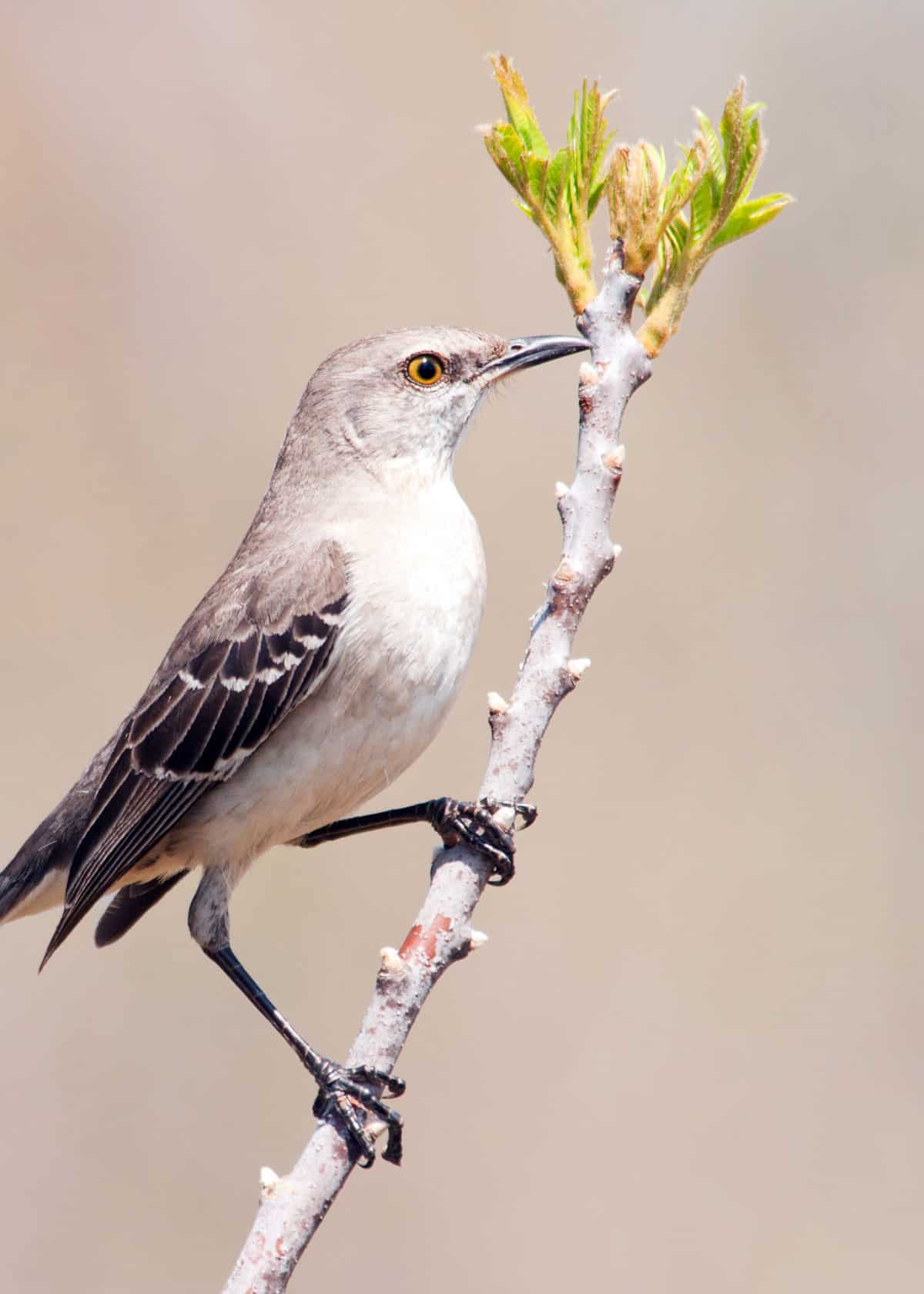
Mockingbirds are intelligent with a great memory and can mimic a wide medley of sounds like other bird songs, frog croaks, human whistling and cat meows.
This black and white bird is socially monogamous but practices divorce and mate-swapping.
8. Australian Owlet-nightjar
- Latin name: Aegotheles cristatus
- Why they are nocturnal: Feeds at night
- Where they are found: Australia and southern New Guinea
- Size: Length: 9.05 inches (23 cm); Weight: 1 to 3.5 ounces (29 to 98 g)
- Diet: Insects (ants, beetles, and grasshoppers)
Both the smallest and most common of the nocturnal birds in Australia, this gray (sometimes reddish-brown) bird lives in mangrove swamps, grasslands, open woodland and dense forests alike.
It mates for life, raises one clutch (2 to 5 eggs) per season, feeds at night on insects, and roosts in tree hollows by day.
9. Little Penguin
- Latin name: Eudyptula minor
- Why they are nocturnal: Swims and forages at night
- Where they are found: Australia, New Zealand, and possibly Chile
- Size: Height: 13 inches (33 cm); Length: 17 inches (43 cm); Weight: 3.3 pounds (1.5 kg)
- Diet: Small fish, krill and squid
Little penguins differ from all other penguin species because they’re smaller, and their feathers are blue and white instead of black and white.

They spend approximately 80% of their lives swimming in the sea and foraging for fish, squid, and krill. During the day, they rest in their ground burrows, safe from predators.
10. Long-eared Owl
- Latin name: Asio otus
- Why they are nocturnal: Hunts at night
- Where they are found: Europe, Asia, and North America
- Size: Length: 12 to 16 inches (31 to 40 cm); Weight: 6.3 to 15.3 ounces (178 to 435 g); Wingspan: 34 to 39 inches (86 to 100 cm)
- Diet: Rodents, small mammals, and birds
One look at this brown-and-buff-streaked owl, and you’ll see why it’s named the long-eared owl. Its ear tufts stand up straight and tall from the middle of its head like antennas.
It’s a secretive owl that takes cover in thick conifer trees during daylight hours and comes out at night to hunt over open country.
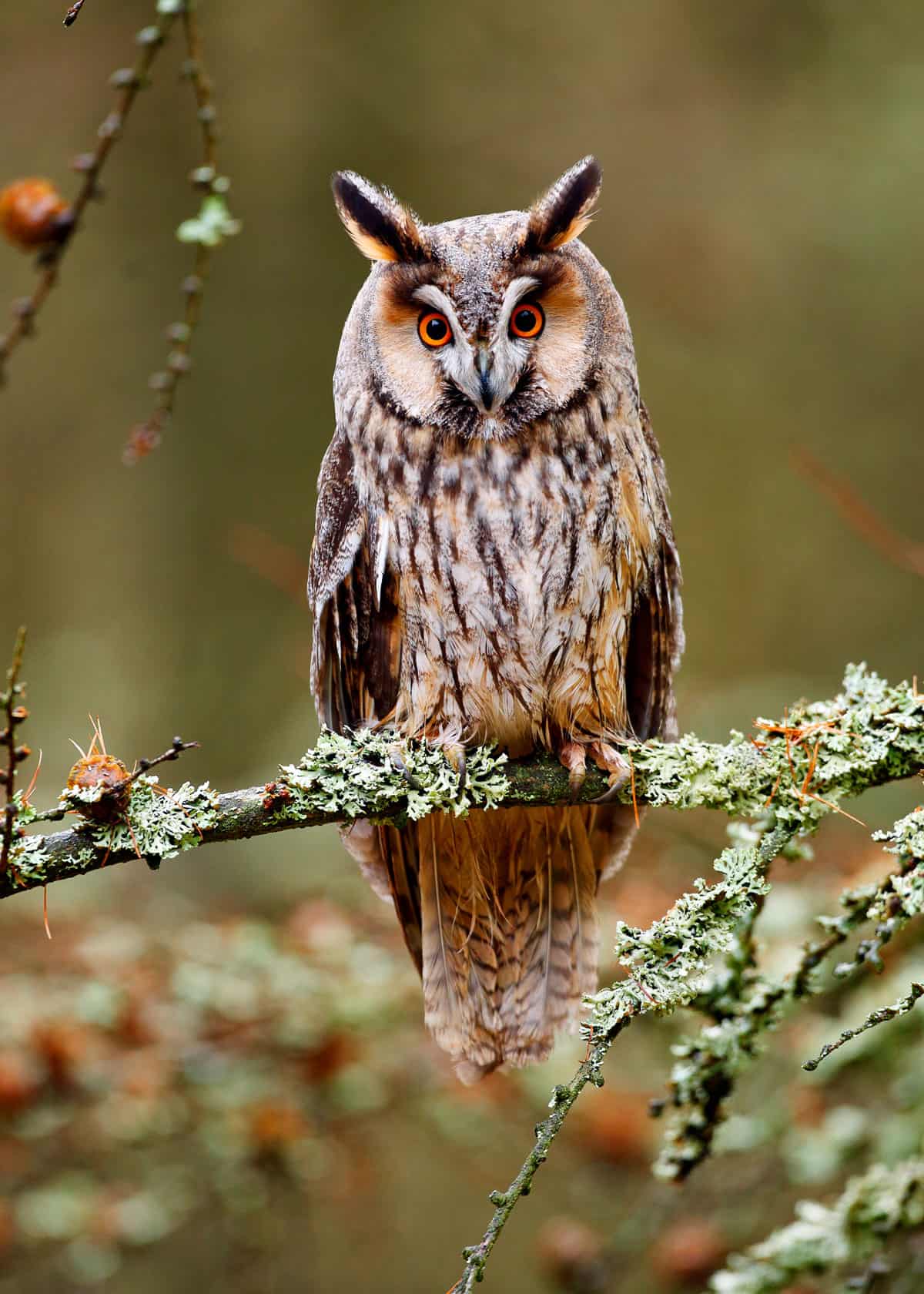
11. Ashy Storm-petrel
- Latin name: Oceanodroma homochroa
- Why they are nocturnal: Feeds at night
- Where they are found: On islands off the coast of Mexico and California
- Size: Length: 7.9 in (20 cm); Weight: 1.8 to 2.8 oz (50 to 80 g)
- Diet: Squid, fish, krill
The ashy-gray plumage of this seabird helps it blend in with the foggy coastlines of California and Mexico, where it lives among colonies.
This seabird feeds on fish and other sea life that rise to the surface at night. It also sticks with the same mate and rock burrow nest for many years.
12. Whip-poor-will
- Latin name: Antrostomus vociferus
- Why they are nocturnal: Forages at night
- Where they are found: North America
- Size: Length: 8.7 to 10 inches (22 to 27 cm); Weight: 1.5 to 2.4 ounces (42 to 69 g); Wingspan: 18 to 20 inches (45 to 50 cm)
- Diet: Flying insects (moths, beetles, mosquitoes, grasshoppers)
A medium-sized nightjar, the whip-poor-will is mentioned in numerous legends, novels, poems and songs across eastern North America.
Named after the sound it makes during the night as it forages for insects, this mottled brown/black/gray bird nests on the ground by day in the camouflage of leaves.
13. Kiwi
- Latin name: Apteryx
- Why they are nocturnal: Forages at night
- Where they are found: New Zealand
- Size: Height: 16 to 19.68 inches (40 to 50 cm); Weight: 4.4 to 7.7 pounds (2 to 3.5 kg)
- Diet: Seeds, fruit, worms, insects, grubs, eels, amphibians
The “national symbol of New Zealand,” the kiwi is a unique, flightless bird that is a cousin to ostriches and emus.
Looking more like a furry mammal with a long beak and four clawed toes on each foot, the kiwi has small eyes but a strong sense of smell that helps it sniff out prey when hunting at dawn and dusk.
Did you know that the kiwi is believed to be the world’s “most ancient bird“?
14. Great Eared Nightjar
- Latin name: Lyncornis macrotis
- Why they are nocturnal: Active at night
- Where they are found: Southeast Asia
- Size: Length: 12 to 16 inches (31 to 41 cm); Weight: 4.6 to 5.3 ounces (131 to 151 g)
- Diet: Beetles, moths, termites
Found in the dense, tropical forests of Southeast Asia, this small bird features ear tufts behind its eyes and brownish-black feathers with buff speckles.
Its legs are weak, so it’s not a good walker, but it does have strong wings that enable it to catch insects while flying at dusk and dawn.
15. Nightingale
- Latin name: Luscinia megarhynchos
- Why they are nocturnal: Sings at night
- Where they are found: Europe, Asia, and sub-Saharan Africa
- Size: Length: 5.5 to 6.5 inches (14 to 16.5 cm); Weight: 0.5 to 0.7 ounces (15 to 22 g)
- Diet: Seeds, nuts, fruits and insects
The nightingale may look like a small bird of drab, light brown plumage, but it boasts a big, beautiful song that has inspired poets, songwriters, and novelists over the centuries.

Bachelor males sing at night to attract a mate. “Married” males follow their wives around to guard and protect them. Bonded pairs usually raise two broods each year.
16. Black-crowned Night Heron
- Latin name: Nycticorax nycticorax
- Why they are nocturnal: Feeds at night
- Where they are found: Every continent except Antarctica and Australia
- Size: Length: 25 inches (64 cm); Weight: 28 ounces (800 g); Wingspan: 45 inches (114 cm)
- Diet: Fish, crustaceans, frogs, waterbird eggs, small mammals
A stocky heron with long, yellow legs and black and white plumage, the black-crowned night heron forages at night in wetlands, making a distinctive choking sound.
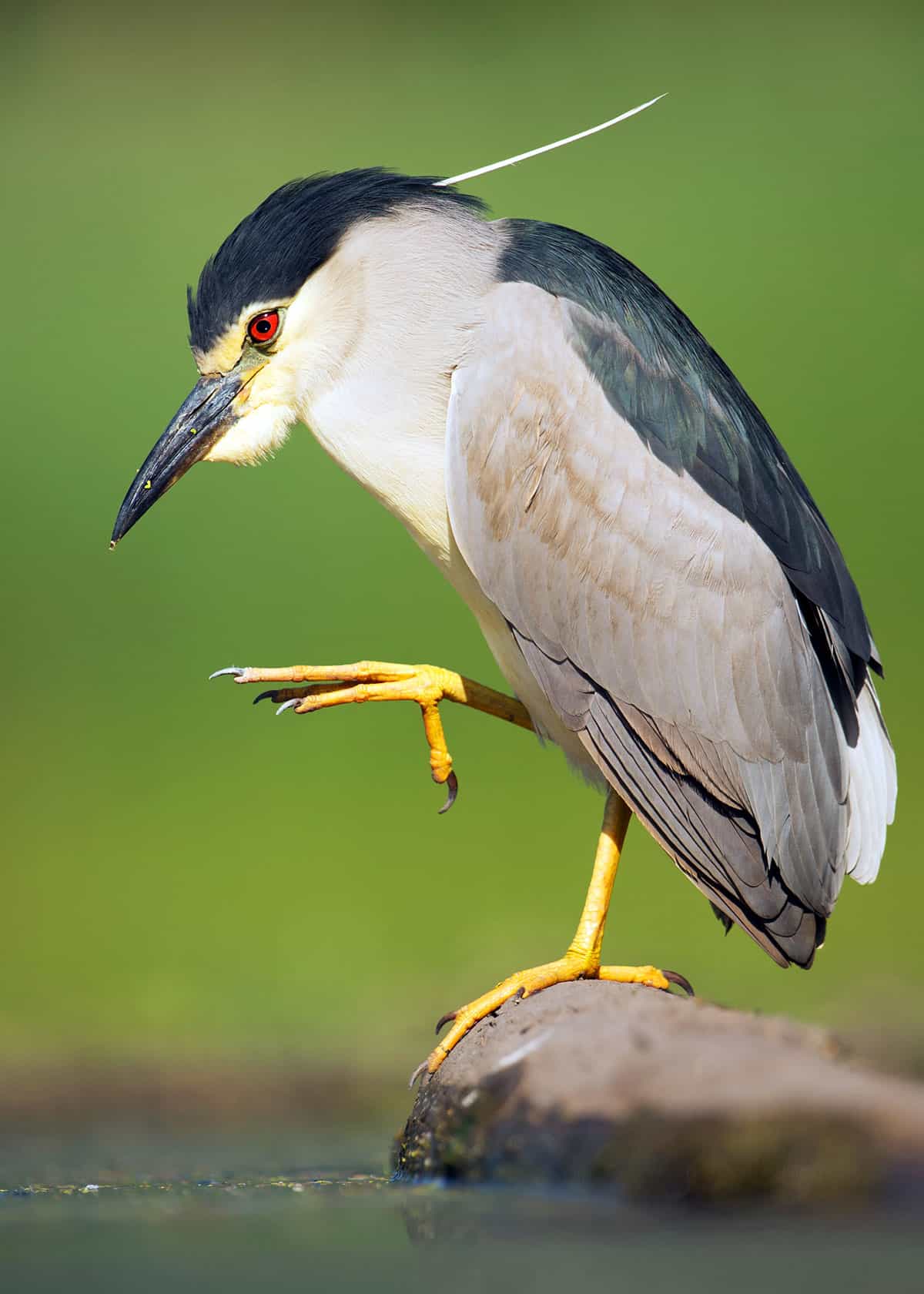
Its stomach acid is strong enough to dissolve the bones of its prey. Nestlings vomit when threatened, and adults are perfectly okay with raising the offspring of other bird species.
17. Potoo
- Latin name: Nyctibius
- Why they are nocturnal: Active at night
- Where they are found: Central and South America
- Size: Length: 19 to 24 inches (48.26 to 60.96 cm): Weight: 12.69 to 22.91 ounces (360 to 650g); Avg. Wingspan: 29 inches (73.66 cm)
- Diet: Large flying insects (beetles, moths, grasshoppers)
The potoo is a strange-looking bird with bulging, yellow eyes, a long neck, a gaping mouth, and mottled brown/green/gray plumage that disguises it as the tree branch it roosts on during the day.
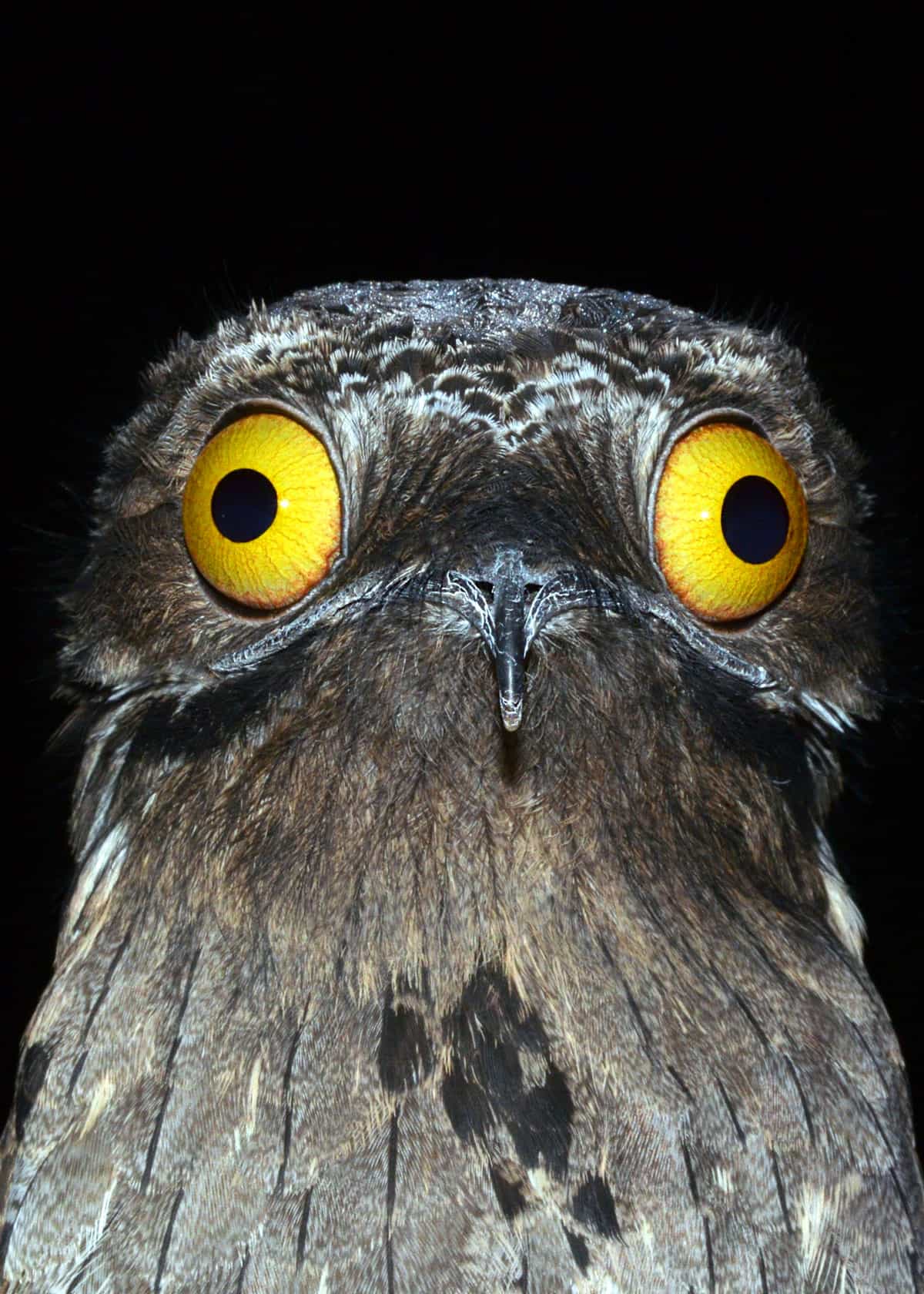
Even stranger is the bird’s eerie call that rings out into the night as it waits to feed on fly-by insects. These nocturnal birds usually mate for life, and both sexes share parenting duties.
18. Corncrake
- Latin name: Crex crex
- Why they are nocturnal: Calls at night
- Where they are found: Europe, Western China, and South-eastern Africa
- Size: Length: 11 to 12 inches (27 to 30 cm); Avg. Weight: 5.5 ounces (156 g); Wingspan: 17 to 21 inches (42 to 53 cm)
- Diet: Earthworms, snails, slugs, beetles, grasshoppers, spiders, dragonflies, seeds
This tan-and-brown-streaked bird with white speckles and a blue-gray face doesn’t nest in corn but rather tall grasslands.
However, it does make a “crex-crex” call that sounds similar to a digital alarm clock.

Males are polygamous and make these calls during the night to attract females. After mating, the female raises a clutch of 8 to 12 greenish-gray, speckled eggs by herself.
19. Indian Nightjar
- Latin name: Caprimulgus asiaticus
- Why they are nocturnal: Active during twilight
- Where they are found: South Asia and Southeast Asia
- Size: Length: 9 to 9.5 inches (23 to 24 cm); Weight: 1.41 to 1.62 ounces (40 to 46 g)
- Diet: Flying/swarming insects and larvae
If you’re driving around at night somewhere in Southeast Asia, your headlights may illuminate upon a small creature that appears to have red, glowing eyes.
That is most likely an Indian nightjar, a small bird of mottled brown feathers and (normally) black eyes.
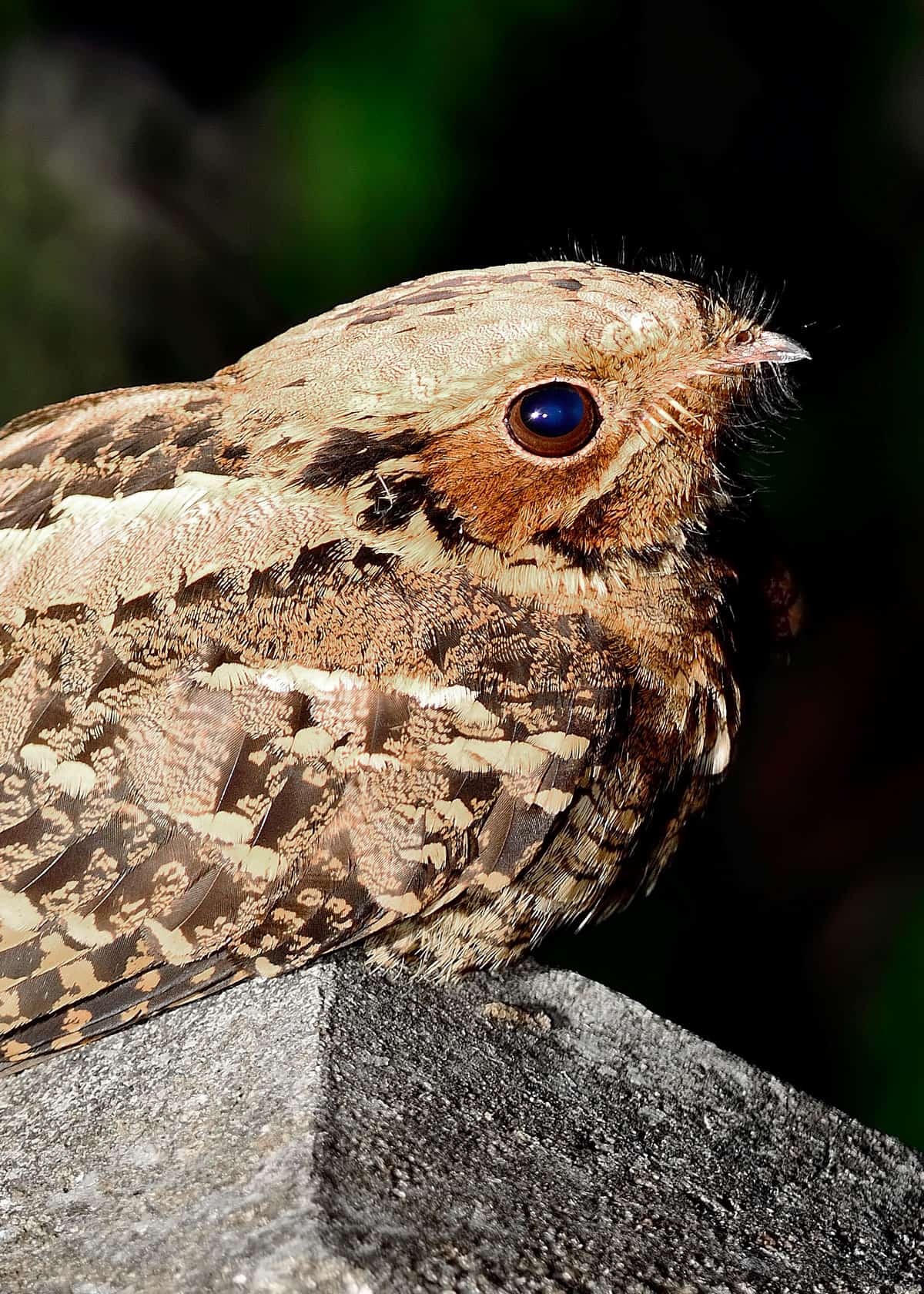
Indian nightjars hang out on roads under street lights, catching insects. It has a unique call that some say sounds like a bouncing ping-pong, but I think it sounds more like a coin being spun upon a tabletop.
During the day, this bird lies motionless on the ground in open woodland or scrubland, camouflaged by its plumage.
When brooding, females lay two marbled pink eggs directly on the ground.
20. Common Nighthawk
- Latin name: Chordeiles minor
- Why they are nocturnal: Hunts at twilight
- Where they are found: North America
- Size: Length: 8.7 to 9.8 inches (22 to 25 cm)
- Diet: Flying insects
This nightjar is not related to a hawk, but it does hunt at twilight at both dawn and dusk. Similar in the drab coloring common to most nightjars, this little bird is noted for the booming sound it makes when abruptly peeling out of a deep dive.
It is usually the male doing this to show off for the female. Just before dawn, you can catch sight of these nocturnal birds flying around in lit areas such as street lights and stadiums.
Your Turn
Birdwatching at night for nocturnal birds makes for an interesting adventure. Did you learn anything from this list that you didn’t already know? Do you have questions? Let us know in the comments!
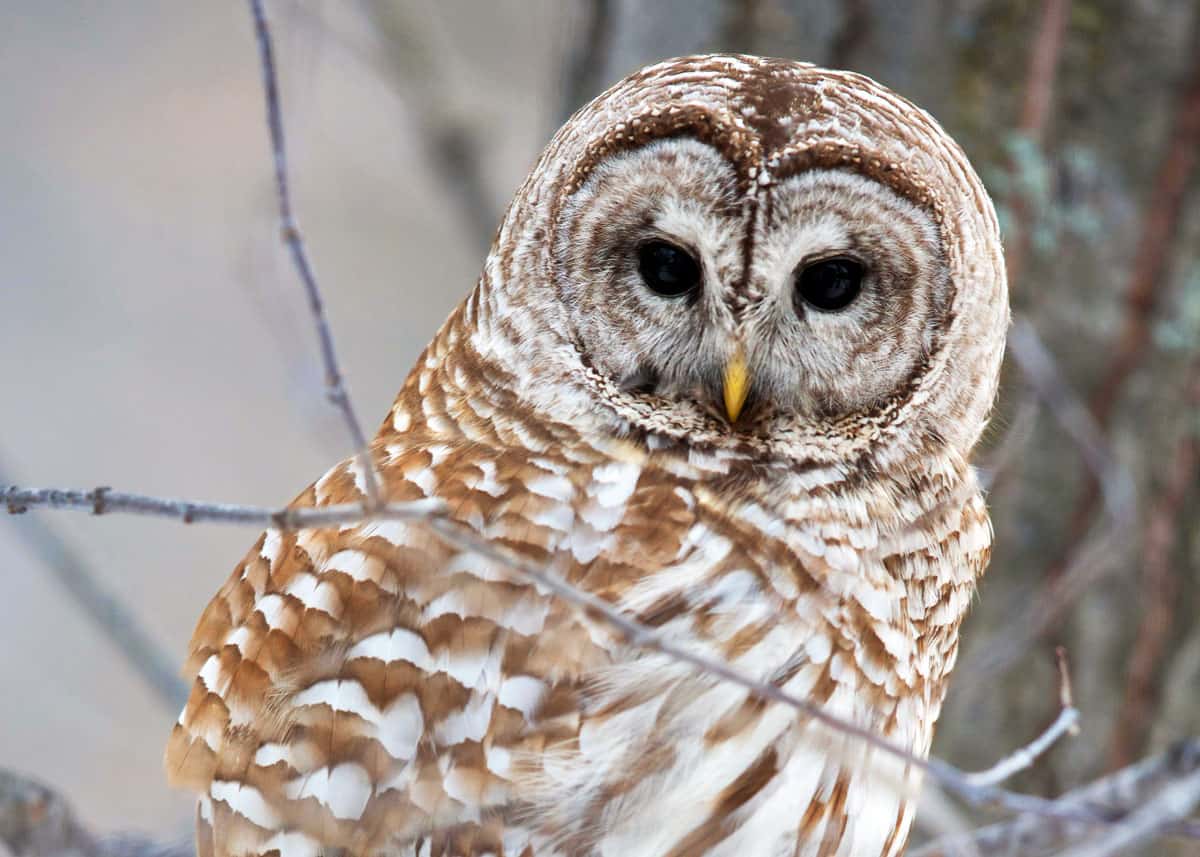
Drew Haines is an animal enthusiast and travel writer. She loves to share her passion through her writing.
She graduated high school at sixteen and started her own business, Everywhere Wild Media. And she runs Everywhere Wild and JustBirding. She also guest blogs on Storyteller.Travel
She lived in Ecuador for 6 years and explored the Galapagos Islands. Currently based in N.S., Canada.





